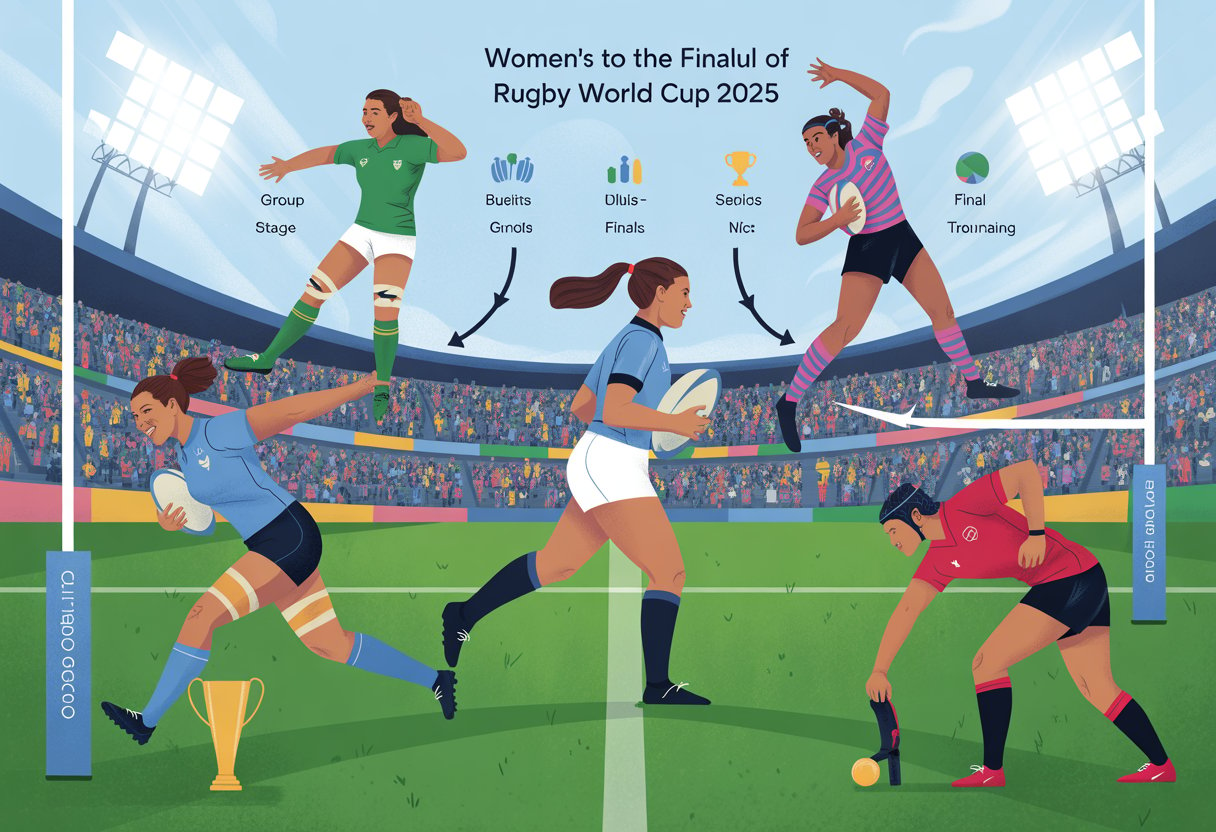The Women’s Rugby World Cup 2025 represents a milestone moment for women’s rugby, with England hosting the tenth edition of rugby union’s premier international tournament. The final will take place on 27 September 2025 at Twickenham Stadium, marking the culmination of a month-long competition featuring 16 of the world’s top teams. This tournament has already broken records with over 220,000 tickets sold, making it the fastest-selling Women’s Rugby World Cup in history.

England enters as the top-ranked team and tournament favourites, carrying enormous expectations as they compete on home soil. The Red Roses will face fierce competition from established rugby nations, each bringing their own tactical approaches and star players to challenge for the ultimate prize in women’s rugby.
The tournament spans from 22 August to 27 September 2025, with matches taking place across England’s most prestigious rugby venues. Beyond the sporting spectacle, this World Cup promises to leave a lasting legacy for women’s rugby participation and visibility across the globe.
2025 Women’s Rugby World Cup Final: Date, Venue and Significance

The Women’s Rugby World Cup 2025 final will take place on 27 September 2025 at Twickenham Stadium in London. This match represents the culmination of the tenth edition of the tournament and marks a historic moment for women’s rugby with record-breaking ticket sales.
Final Match Details
The tournament final is scheduled for Saturday, 27 September 2025 at Twickenham Stadium. This date marks the end of a five-week competition that begins on 22 August 2025.
The final will determine the winner of the tenth Women’s Rugby World Cup. Teams will compete for a new sterling silver trophy with 24-carat gold plating.
England enters as favourites, holding the number one world ranking. They will face strong competition from traditional powerhouses like New Zealand and Canada throughout the tournament.
The timing places the final on a weekend, maximising global television audiences. This scheduling decision reflects World Rugby’s commitment to showcasing women’s rugby to the widest possible audience.
Twickenham Stadium and London
Twickenham Stadium, known as the “Home of Rugby,” will host the final match. The venue is also referred to as Allianz Stadium due to naming rights arrangements.
Located in London, Twickenham holds special significance in rugby history. The stadium regularly hosts major international matches and represents the pinnacle of rugby venues worldwide.
The choice of Twickenham demonstrates World Rugby’s commitment to elevating women’s rugby. Hosting the final at rugby’s most prestigious venue sends a clear message about the tournament’s importance.
London’s position as a global city ensures excellent accessibility for international supporters. The city’s transport links and accommodation options can handle the influx of rugby fans from around the world.
Record-Breaking Attendance and Global Impact
The tournament has already sold 220,000 tickets before any matches have been played. This represents the fastest-selling Women’s Rugby World Cup in history.
The record sales demonstrate growing interest in women’s rugby worldwide. This momentum builds on previous tournaments and reflects increased investment in promoting the women’s game.
Television coverage will reach global audiences across multiple continents. Broadcasting partnerships ensure fans can follow their teams regardless of location.
The tournament’s success will likely influence future investment in women’s rugby. Strong attendance and viewership figures provide compelling evidence for continued growth in the sport.
Journey to the Final: Tournament Format and Key Stages

The 2025 Women’s Rugby World Cup features 16 teams competing through a structured format that includes pool matches, knockout quarter-finals, semi-finals, and a bronze final before the championship match. The tournament spans five weeks from 22 August to 27 September across England’s eight venues.
Pool Stage Overview
The tournament begins with 16 teams divided into four pools of four teams each. Teams play every other team in their pool once during the group stage.
Pool matches take place across multiple English cities including Exeter and Bristol. Each team plays three matches to determine their pool position.
The top two teams from each pool advance to the quarter-finals. Pool standings depend on match wins, bonus points, and point differences.
Teams earn four points for a win and two points for a draw. Bonus points are awarded for scoring four or more tries in a match or losing by seven points or fewer.
Pool stage matches occur over the first three weeks of the tournament. This gives teams time to rest between matches whilst maintaining competitive momentum.
Quarter-Finals
Eight teams progress from the pool stage to compete in the quarter-finals. Pool winners face pool runners-up from different pools in these knockout matches.
The quarter-finals determine which four teams advance to the semi-finals. There are no second chances at this stage of the competition.
Quarter-final matchups are decided by pool positions. The highest-ranked pool winner plays the lowest-ranked pool runner-up.
These matches take place across England’s tournament venues. Teams must perform at their best as one poor performance ends their championship hopes.
Victory margins often remain close during quarter-finals. Teams employ their strongest tactics and player combinations.
Semi-Finals
The four quarter-final winners compete in two semi-final matches. These games determine which teams reach the final and bronze medal match.
Semi-finals typically feature the tournament’s strongest teams. The matches often showcase the highest quality rugby of the entire competition.
Winners advance to the final at Twickenham Stadium. The losing teams play in the bronze final for third place.
Semi-final matches generate significant excitement amongst supporters. Television audiences peak during these crucial encounters.
Teams often make tactical adjustments based on their opponents’ previous performances. Coaching decisions become critical at this advanced stage.
Bronze Final
The two semi-final losing teams compete for third place in the bronze final. This match takes place before the championship final.
Bronze medal matches provide teams with a chance to finish the tournament positively. Many players consider third place a significant achievement.
The bronze final often produces entertaining rugby. Teams play with freedom knowing championship pressure has been removed.
This match allows losing semi-finalists to end their campaigns on a winning note. Players frequently treat it as an important honour match.
Television coverage ensures the bronze final receives substantial global attention. Many supporters view it as essential tournament viewing.
Competing Teams and Tournament Favourites

The 2025 Women’s Rugby World Cup features an expanded field of 16 teams competing across four pools, making it the largest tournament in the competition’s history. England enters as the top-ranked side and home favourites, whilst traditional powerhouses like New Zealand and France pose significant challenges.
Participating Nations
The tournament has expanded from 12 to 16 teams for the first time. This growth reflects the rapid development of women’s rugby globally and provides more opportunities for emerging nations.
The 16 qualified teams will compete in four pools of four teams each. The top two teams from each pool advance to the quarter-finals.
Pool Structure:
- Pool A: England, Australia, USA, Samoa
- Pool B: Canada, England, Wales, Fiji
- Pool C: New Zealand, Ireland, Japan, Spain
- Pool D: France, Italy, South Africa, Brazil
Traditional rugby powerhouses dominate the lineup. England, New Zealand, France, and Australia bring strong pedigrees to the tournament.
Several emerging nations have earned their spots. Brazil, Samoa, and Fiji represent the growing global reach of women’s rugby.
Notable Squads and Stars
England boasts the tournament’s strongest squad on paper. Playing at home adds extra motivation after losing two previous finals.
The Red Roses feature experienced internationals across all positions. Their depth and home advantage make them formidable opponents.
New Zealand remains a constant threat despite recent struggles. The Black Ferns possess the skill and experience to challenge for the title.
France brings technical excellence and forward power. Their structured approach has consistently delivered strong World Cup performances.
Canada and Australia round out the traditional contenders. Both nations have invested heavily in their women’s programmes and possess match-winning talent.
Ireland and Wales represent emerging European powers. Their recent growth suggests they could spring surprises against higher-ranked opponents.
Favourites to Win the Title
England enters as overwhelming favourites with bookmakers and pundits. Their world number one ranking and home advantage create perfect conditions for success.
The Red Roses kick off the tournament against the USA on 22nd August. Eight cities will host matches before the final at Twickenham’s Allianz Stadium on 27th September.
New Zealand cannot be discounted despite their current form. The Black Ferns’ World Cup pedigree and ability to peak at major tournaments keeps them in contention.
France offers the strongest challenge to England’s dominance. Their forwards traditionally match England’s power whilst their backs provide creative flair.
Canada has shown consistent improvement in recent years. Their physical style and growing confidence make them dangerous quarter-final opponents for any team.
The expanded format creates more opportunities for upsets. Teams like Ireland and Australia possess enough quality to reach the semi-finals if they peak at the right moment.
Host Cities and Venues
The 2025 Women’s Rugby World Cup will take place across eight English cities from 22 August to 27 September. The tournament features iconic venues like Twickenham for the final and Stadium of Light for the opening match, with cities like Exeter and Bristol playing crucial roles in hosting pool matches and quarter-finals.
Match Locations
The tournament spans England with matches across multiple venues. Twickenham Stadium will host the final on 27 September 2025. This legendary rugby venue provides a fitting stage for the championship match.
Stadium of Light in Sunderland opens the tournament on 22 August. The 49,000-capacity football stadium serves as the tournament’s starting point.
Eight cities will welcome teams and fans throughout the competition. The venues include:
- Twickenham (Final)
- Stadium of Light, Sunderland (Opening match)
- Ashton Gate, Bristol
- Sandy Park, Exeter
- Additional venues across England
This marks the first time the Women’s Rugby World Cup expands to 16 teams. The tournament increases from 12 competing nations in previous editions.
Exeter and Bristol’s Role
Exeter hosts five pool stage matches and two quarter-finals at Sandy Park. The venue serves as home to Exeter Chiefs and provides an intimate rugby atmosphere.
Sandy Park’s capacity suits the tournament’s goals of creating passionate crowds. The stadium’s rugby heritage adds authenticity to the competition experience.
Bristol welcomes matches at Ashton Gate stadium. This venue combines modern facilities with strong local rugby traditions.
Both cities offer dedicated rugby communities. Their selection reflects the tournament’s aim to celebrate women’s rugby across England’s rugby heartlands.
These venues provide geographical spread across the country. Fans from different regions can access matches without extensive travel.
Significance of Host Selection
The venue choices represent strategic decisions by World Rugby and the RFU. Each location offers specific advantages for players and spectators.
Twickenham’s selection for the final emphasises the tournament’s prestige. The home of rugby union provides global recognition and media attention.
Regional distribution ensures nationwide participation. Eight cities allow more communities to engage directly with elite women’s rugby.
Stadium capacities vary to match different match importance. Pool matches use smaller venues whilst knockout rounds move to larger stadiums.
The selection supports the tournament’s record-breaking ambitions. Previous tournaments attracted over 150,000 fans, with 2025 targeting even higher attendance figures.
Legacy and Cultural Impact of the Women’s Rugby World Cup 2025
The Women’s Rugby World Cup 2025 has created lasting changes through dedicated programmes and record-breaking participation. These efforts focus on growing the sport, inspiring young players, and achieving important milestones for women’s athletics.
Growth of Women’s Rugby
The Impact ’25 programme received £12.13 million from the UK Government to expand women’s rugby across England and home nations. This funding aims to make rugby more accessible for women and girls at all levels.
The Rugby Football Union set a target of 100,000 female players by 2027. The World Cup serves as a key driver for this ambitious goal.
Key growth areas include:
- Community club development
- School rugby programmes
- Coach training initiatives
- Equipment and facility improvements
World Rugby launched Impact Beyond 2025 as a global programme. This initiative captures the tournament’s positive effects worldwide, not just in England.
The programme focuses on creating opportunities for women to participate in rugby. It addresses barriers that previously prevented many from joining the sport.
Inspiring Future Generations
The tournament takes place across five weeks with 32 matches featuring 16 top teams. This extensive coverage provides maximum exposure for young viewers to see elite women’s rugby.
The final at Twickenham’s Allianz Stadium expects a capacity crowd. This setting demonstrates that women’s rugby can fill major venues and attract large audiences.
Players become role models for girls who may not have seen women competing at the highest rugby levels before. The visibility helps normalise women’s participation in contact sports.
Inspiration comes through:
- Media coverage of matches
- Player interviews and stories
- School visit programmes
- Community engagement events
The tournament timing allows schools to incorporate rugby into their autumn programmes. Teachers can use the World Cup as motivation for sports lessons and activities.
Milestones in Women’s Sport
The 2025 World Cup represents the biggest-ever celebration of women’s rugby. This scale marks a significant step forward for gender equality in sport.
World Rugby describes the tournament as “era-defining” for women’s rugby. The unprecedented engagement levels show growing support for women’s athletics.
The event demonstrates that women’s sport can generate substantial government investment. The £12.13 million funding shows official recognition of women’s rugby’s value.
Notable achievements include:
- First Women’s Rugby World Cup with dedicated legacy programme
- Largest government investment in women’s rugby development
- Record anticipated attendance figures
- Most comprehensive global impact initiative
The tournament creates a framework for future women’s sporting events. Other sports can learn from the comprehensive approach to legacy planning and community impact.
These milestones help establish women’s rugby as a professional sport worthy of major investment and attention.
Book Your Exclusive Journey in Comfort
Experience Luxury travel with LPB Chauffeurs. Arrive at Twickenham Stadium in style, we’re ready to provide a comfortable, punctual, and luxurious ride. Reserve now and travel with confidence.
